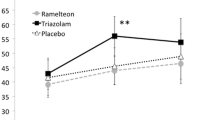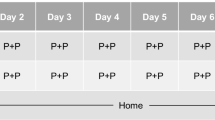Abstract
Objective: To compare the effects of lorazepam, a benzodiazepine-type anxiolytic agent, with those of captodiamine, a non-benzodiazepine anxiolytic agent, on vigilance and on driving behaviour.
Design: Randomised, double-blind, crossover trial.
Study Participants: Sixteen healthy male volunteers, aged 29 to 44 years, medically qualified to drive, holding a driving licence for more than 5 years, and driving more than 15 000km per year.
Intervention: Lorazepam 0.5mg in the morning and at lunchtime, 1mg at bedtime, for 7 days; captodiamine 50mg in the morning, at lunchtime and at bedtime, for 7 days.
Outcome Measures: Principal criterion: driving test on a 900m circuit with assessment of the number of errors resulting from clumsiness, excessive inhibition and disinhibition. Other criteria: psychometric tests (visual and auditory reaction times, tremometric test) and measurement by visual analogue scales of the degree of internal stress, anxiety, drowsiness and reduction of physical and mental capacity. All measurements were made before and after 7 days of treatment.
Results: During the driving test a reduction in the number of errors resulting from clumsiness and disinhibition was observed with captodiamine, whereas an increase in the number of errors was seen with lorazepam (p < 0.001). A trend towards a shortening of auditory reaction time was noted in favour of captodiamine (p < 0.10). The reduction in internal stress was significantly greater with lorazepam compared with captodiamine (p < 0.05). Atendency to drowsiness was noted with lorazepam (p < 0.10). No other trend or significant difference was observed between the two drugs.
Conclusion: Compared with lorazepam, captodiamine improved the concentration and dexterity of individuals when driving, without inducing a tendency to drowsiness.
Similar content being viewed by others
References
Lagier G. Aspects techniques et scientifiques. In Lagier G, editor. Conduite automobile, vigilance et médicaments. Paris: Sejourne-Robert, 1997: 27–100
Vermeeren A, De Gier JJ, O’Hanlon JE Methodological guidelines for experimental research on medicinal drugs affecting driving performance: an international expert survey. J Traffic Med 1994; 22(4): 173–4
Lillsunde P. Commentary, alcohol, drugs users and traffic accidents — a review on epidemiological studies. J Traffic Med 1998; 26(1-2): 5–10
Ferrara SD, Zancaner S, Snenghi R. Psychoactive drugs involvement in traffic accidents in Italy. Proceedings of the 11th International Conference on Alcohol, Drugs and Traffic Safety; 1989 Oct 24–27; Chicago: National Safety Council, 260–4
Laurell H. Benzodiazepines and road accidents. Actes de la 3ème Conférence Vigilance et Performances Psychomotrices; 1991 19-10 Avril; Annecy, France. CERMT Ed. Annecy, 1991: 26-9
Lechat P. Fatigue, médicaments et conduite automobile. Bull Acad Natl Med 1982; 186(6): 773–7
Berghaus G. Concentration-effect relationship with benzo-diazepine therapy. Proceedings of the 14th International Conference on Alcohol, Drugs and Traffic Safety; 1997 Sep 21–26; Annecy, France. CERMT Ed. Annecy, 1997: 705-9
Steentoft A. Other drugs than alcohol in Danish traffic cases, requested by the police. Proceedings of the 14th International Conference on Alcohol, Drugs and Traffic Safety; 1997 Sep 21–26; Annecy, France. CERMT Ed. Annecy, 1997: 1345-9
Mercier-Guyon C. Médicaments, drogues et comportement au volant. Bull Acad Natl Med 1994; 178(6): 1111–22
Mercier-Guyon C. Tests in sedation and tests in risk taking, their interest and their limits in evaluation of side effects of psychotropic drugs applied to driving. Proceedings of the 12th International Conference on Alcohol, Drugs and Traffic Safety; 1992 Sep 28–Oct 2; Rheinland, Köln, Germany: 725-33
Weidmann H, Petersen PV. A new group of potent sedatives. J Pharmacol Exp Ther 1953; 108(2): 201–16
Pentney BH, Brotherwood RW. Captodiamine in anxiety states in general practice. Practitioner 1960; 185: 218
Mercier-Guyon C. Methodological aspects in evaluation of the effects of psychotropic drugs and driving. International work- shop on drugs and driving; 1991: 29 Oct–1 Nov, University di Padova, Italy. ARFI Ed. 1991: 73-5
Mercier-Guyon C, Ducluzeau R, Normand R. Effects of Valpromide on alertness and psychomotor skills. Proceedings of the 11th International Conference on Alcohol, Drugs and Traffic Safety; 1989 Oct 24–27; Chicago, USA, 889-92. National Safety Council
Crocq L, Mercier-Guyon C. Effets de l’association Bromazépam-alcool sur la vigilance et les performances psychomotrices des conducteurs automobiles. Congrès de psychiatrie et de neurologie de langue française. 1989; 3–9 Juillet; Montréal, 496-500
Crocq L, Mercier-Guyon C. Etude en double aveugle des effets de l’association Bromazépam-alcool versus placebo chez 11 conducteurs automobiles. C R TherPharm Clin 1989; 7(78): 2–9
O’Hanlon JF, Verlmeeren A, Uiterwijk MM, et al. Anxiolytics’ effects on the actual driving performance of patients and healthy volunteers in a standardized test. An integration of three studies. Neuropsychobiology 1995; 31(2): 81–8
Martindale, The Extra Pharmacopoeia. 31st ed. Reynolds editors. The Royal Pharmaceutical Society, London 1996
Kay GG, Berman B, Mockoviak SH, et al. Initial and steady state effects of diphenhydramine and loratadine on sedation, cognition, mood and psychomotor performance. Arch Intern Med 1997; 157(20): 2350–6
Author information
Authors and Affiliations
Corresponding author
Rights and permissions
About this article
Cite this article
Mercier-Guyon, C., Lejay, J. & Choay, P. Comparative Study of the Effects of Captodiamine and Lorazepam on Car Driving Ability. Clin. Drug Investig. 17, 451–459 (1999). https://doi.org/10.2165/00044011-199917060-00005
Published:
Issue Date:
DOI: https://doi.org/10.2165/00044011-199917060-00005




